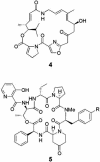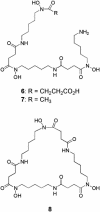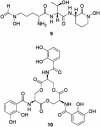Synergy and contingency as driving forces for the evolution of multiple secondary metabolite production by Streptomyces species
- PMID: 12970466
- PMCID: PMC304118
- DOI: 10.1073/pnas.1934677100
Synergy and contingency as driving forces for the evolution of multiple secondary metabolite production by Streptomyces species
Abstract
In this article we briefly review theories about the ecological roles of microbial secondary metabolites and discuss the prevalence of multiple secondary metabolite production by strains of Streptomyces, highlighting results from analysis of the recently sequenced Streptomyces coelicolor and Streptomyces avermitilis genomes. We address this question: Why is multiple secondary metabolite production in Streptomyces species so commonplace? We argue that synergy or contingency in the action of individual metabolites against biological competitors may, in some cases, be a powerful driving force for the evolution of multiple secondary metabolite production. This argument is illustrated with examples of the coproduction of synergistically acting antibiotics and contingently acting siderophores: two well-known classes of secondary metabolite. We focus, in particular, on the coproduction of beta-lactam antibiotics and beta-lactamase inhibitors, the coproduction of type A and type B streptogramins, and the coregulated production and independent uptake of structurally distinct siderophores by species of Streptomyces. Possible mechanisms for the evolution of multiple synergistic and contingent metabolite production in Streptomyces species are discussed. It is concluded that the production by Streptomyces species of two or more secondary metabolites that act synergistically or contingently against biological competitors may be far more common than has previously been recognized, and that synergy and contingency may be common driving forces for the evolution of multiple secondary metabolite production by these sessile saprophytes.
Figures




References
-
- Demain, A. & Fang, A. (2000) in History of Modern Biotechnology, ed. Fichter, A. (Springer, Berlin), Vol. 1, pp. 2-39.
-
- Berdy, J. (1995) in Proceedings of the Ninth International Symposium on the Biology of the Actinomycetes, eds. Debabov, V. G., Dudnik, Y. V. & Danilenko, V. N. (All-Russia Research Institute for Genetics and Selection of Industrial Microrganisms, Moscow), pp. 13-34.
-
- Williams, D. H., Stone, M. J., Hauck, P. R. & Rahman, S. K. (1989) J. Nat. Products 52, 1189-1208. - PubMed
-
- Donadio, S., Staver, M. J., McAlpine, J. B., Swanson, S. J. & Katz, L. (1991) Proc. Natl. Acad. Sci. USA 252, 675-679. - PubMed
-
- Firn, R. D. & Jones, C. G. (2000) Mol. Microbiol. 37, 989-994. - PubMed
Publication types
MeSH terms
Substances
LinkOut - more resources
Full Text Sources
Other Literature Sources
Molecular Biology Databases

